#nanase ohkawa
Explore tagged Tumblr posts
Text
Clamp Art Style Analysis: Part 1: Creation Process and Materials

Introduction
Clamp is a manga artist team of four women. They are a prominent distinguished manga artist team known in the West and in China. The thing they are most recognized for is their highly detailed art style many people may have known and many may not. They did several manga you might have known such as Card Captor Sakura, Chobits, and even Tsubasa.
Clamp is one of the artists whose art style I highly admire and want to imitate in my art. I created this post so I can understand and take apart their art style and better understand it. It is going to be difficult since there are four people with different specialties and years of professional experience in their belt. They are constantly changing and adapting to every genre.
I am going to analyze Clamps’ art style in this post and this may take a while to crack due to how extensive the Clamp style is. I am going to pile up everything and explain this in this post which is going to take time to explain in this post. I am going to take apart interviews from different sources while explaining their art style in this post.
I am going to examine their art style and the materials they use. I am going to split into sections talking about the art style and what they use for materials for the manga.
To understand the art style and how it is defined I need to understand Clamp themselves since they created an entirely individual style that is going to talk about other things, not about the art style there is going to be so much I might miss while explaining in this post. I could be wrong while explaining this is an analysis I am going to take my crack at understanding the art style.
Influences
Though the members of Clamp are largely self-taught they are inspired by many figures that influence their art. The list consists of Reiji Matsumoto, Osamu Tezuka, Go Nagai, Hirohiko Araki, and Moto Hagio. The other works that influenced Clamp are animated cartoons and Galaxy Express 999. Reiji Matsumoto and Osamu Tezuka are major influences in their works Clamp used Osamu Tetsuka’s star system in their works which is seen often in the crossing over of characters from their series into their other works. You can see this prevalently in Tsubasa, X, and Kobato where you would find characters from the different series crossover.
Nekoi's favorite cartoonist was Moto Hagio in high school and Mokona mimics pictures by Reiji Matsumoto when she was younger.
While working on manga Nekoi started copying Shinji Wada and Rumiko Takahashi, in which She copied her art in drawing legs. She drew them thick and big. She liked the legs Rumiko Takahashi drew since they seemed long until short feet. She took them to make them more delicate and feminine. Clamp used other artists to help them while drawing.
Go Negai influenced the creation of X, taking inspiration from his work of Devil Man featuring two main male characters, and the murder of the lead's sweetheart triggers the apocalypse. Devil Man is used in creating x The extreme levels of violence depicted in X came from Go Negai's works. Clamp knows about Devil Man. They did a doujinshi of Devil Man in their works as doujinshi artists a while back and even had a doujinshi about the lead character's relationship in their works.
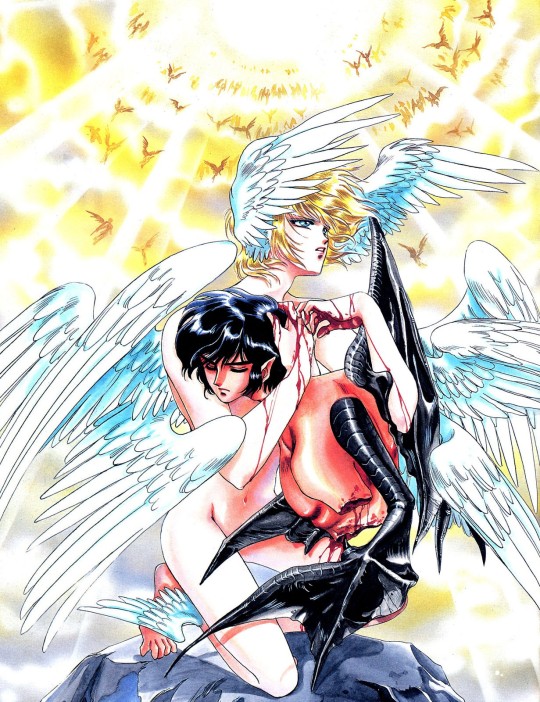
X was inspired by Go Nagai the heavy violence in x inspired from Go Nageis works and the assembled cast of x is inspired by Kyokutei Bakin's Nansō Satomi Hakkenden, The fight sequences of x were inspired by the manga Dragon Ball specifically Akira Toriyama's use of white backgrounds.
Mokona influences are H.R Giger and gérard di-maccio are used for the RG veda backgrounds.
Mokona likes Alphonse Mucha who is a considerable influence in drawing XXXHolic art.
Hirohiko Araki is another influence of Clamp with JoJo's Bizarre Adventure fan manga back when they drew doujinshi and starred in Clamp in wonderland animation with Jojo animated.

They drew a doujinshi on Jojo a while back starring Josuke and Kakyon and even they drew Jolynn once.
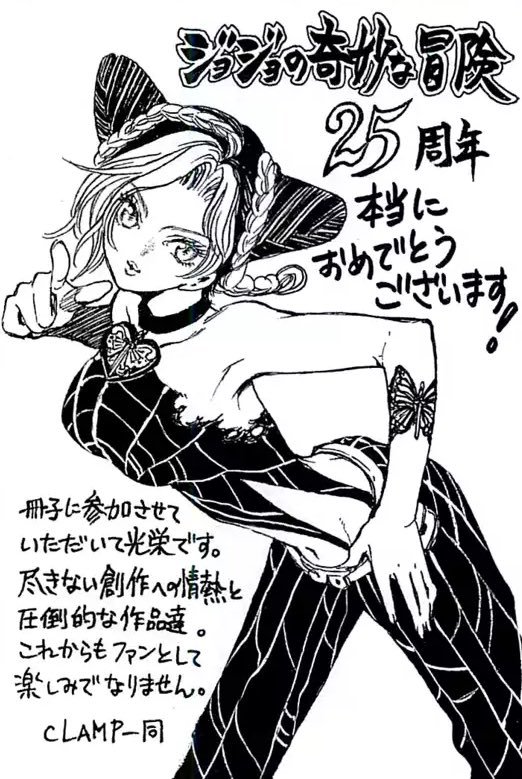
There is a lot of Kakyoin and Josuke fanart with Yaoi art drawn by these two characters.
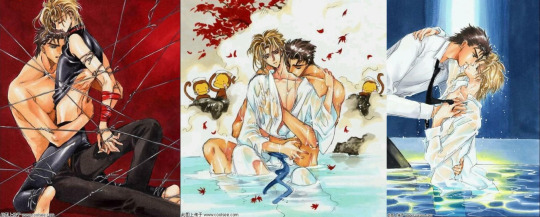
Jojo was used in drawing wish with Kohaku and Shuichiro strongly resembling Jotaro Kujo and Noriaki Kakyoin and Kohaku's hairstyle strongly identical to Kakyoin and Shuiichiro resembling Josuke.
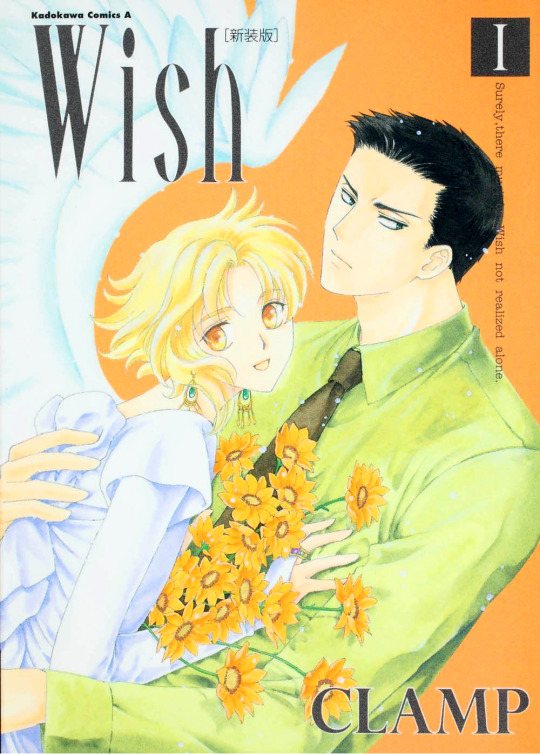
Members

Nanase Ohkawa
The main leader of the group, the main writer of the scenario, is in charge of the original story, script, and design. The other three artists are Mokona, Nekoi, and Satsuki, who are in charge of the art.
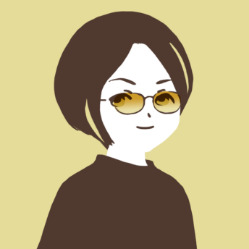
Mokona
Mokona is the artist and designer in charge of drawing. Mokona is in charge of sketching out the construction of the characters by hand. Mokona draws the storyboards and sketches out the characters. Mokona is responsible for drawing female characters.

Tsubaki Nekoi
Nekoi is in charge of character design, background scenery, finishing touches, and charge of the foundation of the art in their works. Her booth has been painted for design and screens for finishing touches.Nekoi likes to doodle and throw pages. Nekoi is in charge of drawing male characters.

Satsuki Igarashi
Satsuki Igarashi is in charge of design and drawing and is in charge of the finishing touches. She is in charge of designing the cover of the book itself.
Bio
Three members of Clamp were classmates in high school who took art-focused classes in school; none of them studied at school for manga. Nekoi tried using colored pencils and opaque watercolor in school when she was young. Satsuki and Nekoi were in middle school when they first started drawing manga. Mokona was in an art club in middle school. In high school, she started drawing manga with proper frames and dialogues. Mokona, Nekoi, and Igarashi studied art in high school Nekoi, Mokona, and Igarashi met in high school as a kid She found a friend who loved manga, Satsuki went to an art-type highschool and Mokona high school and college had art-focused classes, Igarashi was at an art department in highschool then to computer graphics vocational school. Clamp started as doujinshi artists who first published doujinshi fanzines Back then they had more people it went down to four in the year of their commercial debut.
The group never worked as assistants with most of the members being self-taught with Tsubaki and Nekoi being more self-taught.
They never used assistants to help them with their work since they wouldn’t be able to understand the years of jargon they created among themselves They created work for years without any help from assistants since assistants would slow them down and wouldn’t understand when we would tell them to do the same thing as before disrupting the workflow they created for work.
For inspiration, Ohkawa gets her ideas from dreams or inspiration based on events she hears or sees on the news a lot of times its deadlines. Ohkawa doesn’t always take notes and she usually loses ideas.
Clamp’s daily work hours while working on manga is in the morning, get in the studio at about 10 or 11 in the morning and in the afternoon they eat dinner at 6 in the evening then stop working at midnight.
The members share a single workspace and are separated into three booths while they work.

There are four separate studios and the member's workspace accommodates all four of them. Clamp work requires complete perfection with members having their own space where they have to work to create one of their works
The art of Clamp is lush layered and amazingly detailed. It has a high-quality art style with extensive details. Due to this, it's almost difficult to adapt to animation.
Each of Clamp’s titles has a different art style depending on the genre or magazine they are running in; their art styles change to suit the work and magazine the manga will appear in. The art style of the work is based on Ohkawa’s decision in charge of the art direction of the work. The art styles and pictures have changed but not their methods.
There is a lot to talk about the Clamp art style which may not be enough to explain one segment
Creation process
Clamp's work process is similar to an animation production; they work like a small animation studio. if you look closely at the work process for creating works it's more like an animation with the director, playwright, character designer, painter, background artist, creator, and publicist treating the manga or story like a script for a movie or anime, the creative process for creating manga is similar to that of animation and movies.


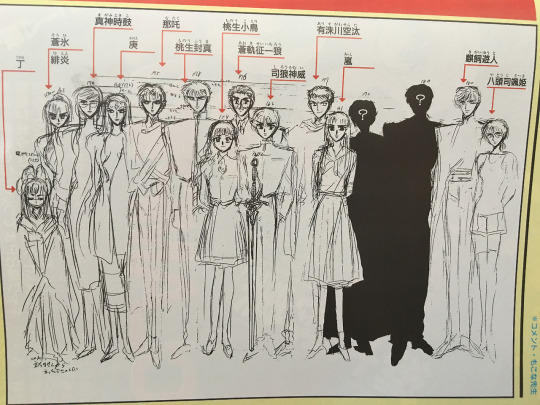
Ohkawa is the storyteller and writes the scripts other three draw drafts and original design, Mokona is the chief character designer, and Tsubaki and Nekoi work for the background Sometimes they they take turns doing different jobs
Ohkawa writes then it goes to Mokona who draws out the outline of the storyboard and sketches the characters
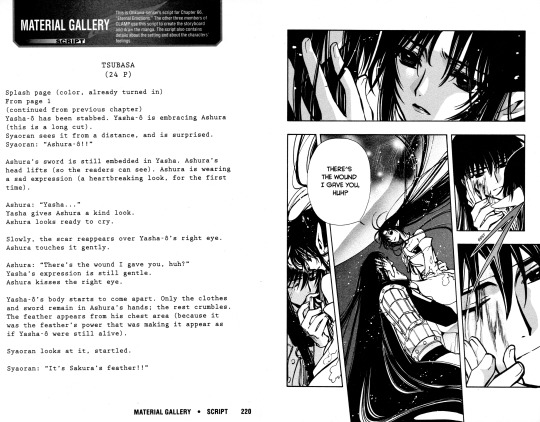
They would normally go to Nekoi for the finishing touches Igarashi and Nekoi work on the final touches the team may shuffle roles. Clamp members do get outside work with computer graphics. For drawing sometimes the members do character backgrounds or may draw everything depending on the story. They have a work where one person designs the character and another draws the actual story. They make storyboards and start drawing. Sometimes they decide who is going to make storyboards and then start drawing. The art is drawn by Satsuki, Mokona, and Nekoi, Nekoi draws the rough draft and thinks about how the story is going forward to next month's script. The designs are handled by Satsuki and Mokona. Satsuki worked on the design for the cover page. In the beginning, they believed that everything in the comic from front to back was important to the story. They take turns completing the rough sketch depending on the story. They divide the story into frames; they mostly draw it on art board paper after they create characters and scripts. Ohkawa explains what in each frame props and the characters in they have how they turn around and include emotions in the panel. Ohkawa and Igarashi never drew manga with split frames. They Look like frames from a movie
When Ohkawa comes up with stories Ohkawa drafts the outline of the story and the story setting The ending for each story is determined from the last scene back to the first scene and the end last and deciding the thing and heading into this way makes way for change drags the reader along for the story Ohkawa drafts the outline the other three members formulate characters designs by creating character profile sheets to avoid confusion. Ohkawas style of writing is considered a color woodblock print in the way it conveys and portrays things the manga is close to picture books and elimination of everything unneeded. Ohkawa thinks about the setting of where the story takes place and Ohkawa constructs a visual image at least in their head then splits up panels in their manga. for the writing process, they come up with the story Ohkawa gets together to discuss the story with the members about the purpose of the story and the main characters when writing and drawing After the members get well used to the story they write it down when creating a story for a weekly magazine they first decide on a rough story from beginning to end Ohkawa works backward from the ending for the story to have an ending like this the members don’t always know how the story develops. Ohkawa's style of writing for stories is not telling anyone the progression of the storyline before it happens reason for that is that when the members of Clamp learn of Hokuto's death one of the members couldn’t draw Hokuto's smile the same way this is how badly shaken they were since that the way Ohkawa created her stories changed for most of the works it was until Chobits she could tell them again. Ohkawa kept using memos in the beginning when she wrote the stories where she kept track of the flow of the story.
Before they start drawing they decide the flow of the story up until the end as well as the materials used for color and monochromatic drawing and the direction of the illustration. The members consider the art style during the planning stage and the materials for the manga, for materials Clamp uses color samplers In the order of how they draw. They draw them the same size as manuscripts, they draw rough sketches, and the size of the manuscript is b4 size and genkou size. They seldom use computers to create manga but only to color pictures, sometimes Clamp uses the scanning method when they draw or draw the rough draft using tablets. They don’t use references for their designs except at one time for Ohkawa she drew inspiration from a perfume and drink package she gathered together she drew more influence from the business art and art from Alan Chai's design.
The amount of lines and the thickness of the lines in the manga depends on the work. When you look at the manga, there are a lot of lines in the characters, Clamps can make the lines, and the thickness of the lines depends on the nature of their work from the thicker lines shows how serious and heavy the story thicker lines match the nature of their work that fits with a heavy theme like works like Tokyo Babylon, which have a heavy atmosphere. Mokona draws with thicker lines and uses pens with strong pressure when drawing. Clamps drawing methods changed with Tsubasa and xxxholic.
In the process of launching a serialization first is to decide on the major storyline work out the details of the characters later and consider the number of chapters needed to tell a story, second Ohkawa has a meeting with Mokona and Nekoi to decide on the design of the main characters Ohkawa asks for designs once they are finished they go over one more time. They go about creating manga and have two processes, one creating a manga based on the request from a publisher The second Clamp decides on the story first and then thinks about the magazine to write it for. Clamp comes up with an outline for the story First after they create the outline they discuss who's going to draw pictures or if they all draw together. They turn the project into a movie telling how a story goes and who the main characters are among themselves. They talk about the rough story and how they should do it when they bring a story to the publisher, attach the rough story and characters, attach characters' settings to them and draw the appearance in the manga to the publisher. Then after they show the work to the editor if the editor thinks it's okay they start the story. After receiving approval from an editor, Ohkawa assigns roles to each group member and then chooses the visual styles depending on the factors such as the complexity of the story and chosen art style the artwork depends on the genre and magazine of the story. Ohkawa provides a rough draft for each chapter with things such as dialogue panel size props and movement and characters' emotions. Storyboarding takes 12 hours while the script takes 8 hours to write. To Mokona from rough draft to inking 10 pages per day, the average Mokona puts into how many pages of black and white manuscript draws in a day the number of pages they draw in a month to finish one installment For example if they're in two monthly publications like Tsubasa and xxxholic one is about 19 or 20 pages other takes one day to finish 6 pages for the foundations for the fishing touches and inking takes a couple of days every 2 weeks when it comes to two weekly series its 120 and 130 pages a week. xxxholic takes two days and x took four days
Ohkawa will specify the proper production for the story and character. After the story, they will choose a person to perform the character design. Clamp switches up who works on character design and the drawing. Igarashi and Ohkawa do it together. One of them directs the work for design and the person in charge of the drawing for that work will draw a rough sketch which is discussed. Mokona is one of the concept artists When the scenario is specified in detail, Mokona listens to the basic story and consults the original concept with Ohkawa Mokona will show what she designed on the spot of the drafting and period. Mokona and Clamp often decide on the design first, then Mokona draws the illustration from format, paper, and photoshopping specifications to color specification. Mokona does pencil drawing first then ink and color it the pencil stage first so Mokona can fix errors in the pencil stage. Ohkawa as the main scriptwriter Ohkawa determines the story and setting and tells the members about it and the rest give their thoughts on it Ohkawa maps out the location, ideas, and character design Ohkawa gives the character's figures hairstyles, and clothes she envisions to the designers or sometimes Ohkawa draws them herself only sketches the rest get the art close to Ohkawa original version. Ohakwa doesn’t talk about the characters until it's time to create their visual design, Ohkawa decides the design of the character and the group visualizes it She explains their appearance she sometimes brings sketches instead of explaining Ohkawa decides the characters they have long or short hair their style of clothes and complexity. Clamp discusses together and thinks about how to make characters, Ohkawa makes requests and discusses them with the other three Ohkawa gives concrete and specific thoughts on what she wants the main characters to be. Ohkawa is the one who decides on the details of the characters and Clamp crafts their characters. They explain the story in the works that include the drawing of the clothes of what the character wears. Ohkawa takes all the info she gathered and has them design the characters based on the descriptions she gave like body build, hair length, and small details, next decide who is going to design the characters either Nekoi or Mokona design them characters and pick one of them then make a character setting chart and decide on the character's height. After the story they choose a person to perform character design. When that is happening, they use specific proper proportions for the story and character. They come up with a story through a character design phase Clamp and choose different styles and proportions for the characters. When it comes to designing characters they determine the head and body ratios since the person drawing can change the proportions in their sketches without knowing. They reference the proportions of the characters in case the person drawing it gets it wrong. Igarashi and Ohkawa consult each other and ask for revisions so that the proportions don’t shift, so it can come in tandem when working for 4 people. Mokona had difficulties drawing Yuko's proportions; she considered drawing them constantly a nightmare. Mokona found it reassuring to have partners who can check your work. Sometimes they decide on the colors to get the approval of the publisher to work on the storyboard and then agree on the birthday and height of the characters. The height is important because it's for drawing proportions that are made to keep consistency when drawing characters. The character designs look like character sheets like the ones you would see in anime. When they first set out to draw the members consulted such things as whether or not thin lines mesh well in the manga. what color materials they would be using the members play it by ear as they go along when they draw. Before drawing the portraits of the characters, Nekoi takes special care of the characters by differentiating them with their hairstyles.
For creating the clothes for the characters, Clamp dresses their character in stuff based on their own or things their acquaintances wear. Clamp reads a lot of informational magazines and fashion magazines on a personal basis which serves as inspiration for characters. Some of the clothes and other items that characters in Clamp wear are inspired by real-life pieces but most of them are done initially by Mokona.
Once the main characters are completed, they decide on the detailed settings for those characters, The members decide on each character's birthday and height. The height is used for doing the proportions of the characters. for the character settings the group goes into detail about the characters like what food they eat, special skills, how and when they do things, how they grew up, when they were young, their hobbies, the type of house they live in whether its Japanese or western style, if they are sleeping wearing pajamas or negligees and whether they like sweets or not; for example if a character is eating sweets it means that a character grew up in an environment where sweets can be easily eaten and if a character has long hair it can be tied or untied these details reference the characters way of life and polices the reason Clamp focuses on what a character likes to eat is because what a person eats says a lot about a character in personality. There's a lot of thought that goes into making character settings. It's mostly to advance writing their characters or fleshing them out as individuals. The character settings are important when writing the characters in the story These details are important for them to write for the characters the character profile is used so they won’t get confused when writing a character for the story to keep the writing of the character to remain consistent throughout the story.
Materials
When drawing manga and illustrations the group often determines the materials they use to draw during the meetings
Once they set out drawing they first consult things like whether or not thin lines and colors. Clamp used different techniques, art materials, and paper when they did manga and color illustrations Clamp used different materials at their disposal. For drawing Rayearth, the materials they use to draw manga are used include other works as well. The heavy colors are used to suit the tone of the story. This goes to show that you can change the impression by changing the pen you use and the paper used.
You can change the impression based on the paper you use. The paper makes a great first impression on the manga. Paper is not the only thing that changes the impression of the manga they draw, also the materials they use are used to change the impression.
Clamp uses different paper sizes for each work, the manga paper is sorted for each one of the members to use. Clamp has strong drawing pressure for their strong drawing pressure they chose thick paper. They use paper made by Daieidou printing for manga drawings because the members have a strong drawing pressure so they chose a thick paper that's three times thicker than manga paper. For the paper that the members use for illustrations Igarashi, Nekoi, and Mokona use Watson paper, BB Kent back of manga paper of copy paper. Both Ohkawa and Igarashi like acid-free paper, they love the sandy texture and don't like smooth art-coated paper. The reason for that is that if the paper is too smooth the texture will not be the same. Clamp uses many materials for works such as Copic markers and alcohol-based products, They use Kaimei Indian ink, and for color inks, they use Holbein and Holbein special black The screentone they use Brans that Clamp uses is I.C. 's and Letraset.
When they first used computer equipment, they were instructed by Takeshi Okazaki and Katsuya Terada. satsuki was into photoshop so Takeshi Yamazaki gave satsuki lessons in photoshop.
For the materials that Clamp used in their past works, rg veda used color inks, aeroflash, Liquitex, and modeling paste, Rayearth used Copic markers, Mokona used color inks for Mask of 20 faces, Tokyo Babylon used color tones and angelic layer had them use thick fountain pen like liner markers for drawing the manga.
Mokona’s pen uses a Kabura and a Marupen. Depending on the weather she draws a line to see which is better. Her favorite pens are Zebras Maru pen and Kabura pen nibs. with lnks, her favorite is Kaimei Indian Ink and Holbein’s Grey or Nouvel’s Burnt Sienna. What she used to draw backgrounds is Pigma 0.05, Mokona has strong drawing pressure. The G pen is too soft for her. She tried using one but it is hard to adjust and prefers using a harder pen. She uses a magic marker with a pigment ink called Prokey she used to draw letters on paper and uses Pentels water-resistant brush pens for solid areas like hair. She uses a powder board for paper with larger pieces and Baron Kent paper stretched with water. For RG Veda backgrounds Mokona used a lot of airbrush techniques. Mokona draws with thicker lines, and her drawings have been drawn with thicker lines. In the beginning, like in the third volume of Tokyo Babylon, the character's faces are angular and have thicker lines which show that her art is changing. Syaoran was Mokona’s favorite character to draw in Tsubasa.
Nekoi uses different nibs for the maru pen and g pen; she uses the Kabura pen for concentrated and close straight lines, also Pigma 0.5 for backgrounds.

For paper Nekoi uses whatever paper they have at hand to the back of wrapping paper bits of cardboard that have fallen around the back of cosmetics box envelopes from the publisher, the wrapping paper from a cup of tea that is Japanese style. She uses an eraser to reduce the tones in the screentone and sandpaper to reduce the large areas of tone she uses. A fine grit sandpaper will decrease nicely but not allow for fine adjustment which she had to fix with an eraser later. Nekoi loved experimenting with new painting materials; she especially loved painting in color.
Step to Step in Creating Manga
When it comes to drawing manga there are steps taken to create manga. these are the materials they use for drawing manga The list of materials and things they use in the steps to create manga are listed as this
1.) plastic eraser, mechanical pencil 0.5 HB
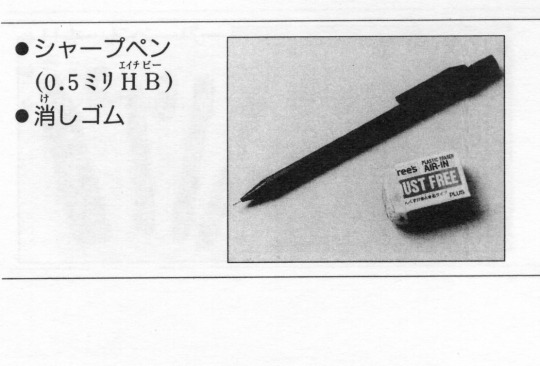
2.) Pigma 0.5, magic marker

3.) brush pen
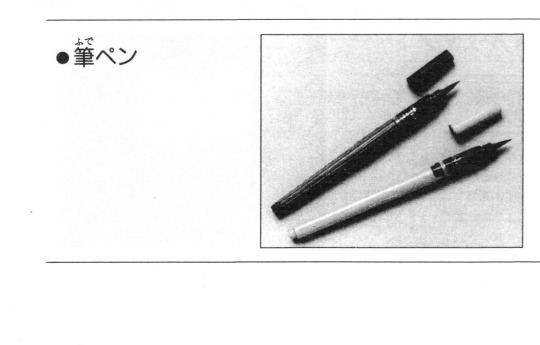
4.) screen tone, tone cutters round sand eraser

5.) pen white, liquid paper ink, Mython
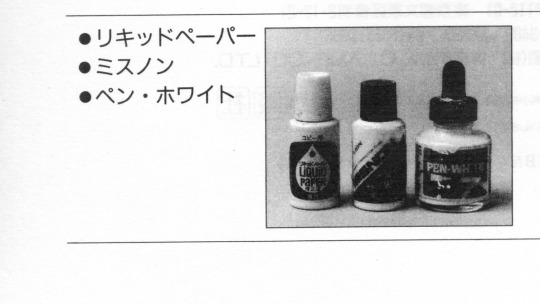
lastly, for writing the script, they use a pc
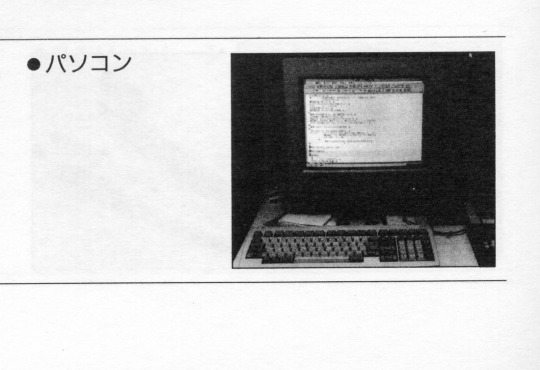
For the steps they use to create manga Rayearth I think it might be the same steps they use to draw other manga that come after it might be the same steps they did for Tsubasa,xxxholic, and other manga that come after it, and the materials they use. I bet it's the same materials used for Tsubasa, Card Captor Sakura and xxxholic.

1.) The plot is written by Ohkawa on a personal computer with manuscript paper, For the rough they draw frames with a pencil and roughly insert characters and other elements, they draw the rough while paying attention to the composition and balance the draw the panel as to what you want to show most when you are doing a specific scene. The rough is a lot of lines and its way is less detailed. The rough is used for the placement to know the place of things to ink. You can see the same rough stage with Tsubasa and xxxholic.
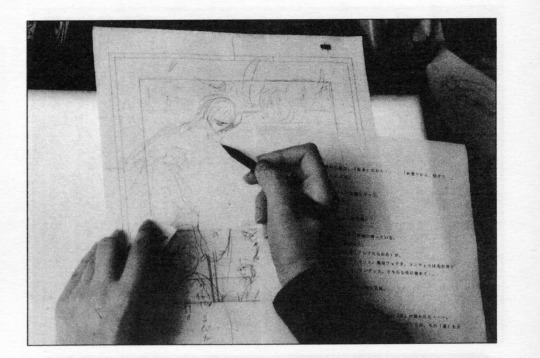
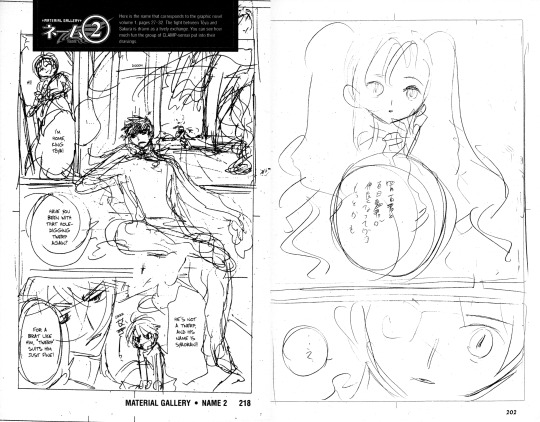
Clamp pays attention to the distribution of lines in the panels, the reason why Clamp pays attention to the number of lines is because it's a manga and they are going to ink over and over again. The reason they pay attention to the number of lines in the rough is to calculate how much you ink while you draw. the number of lines you use while you ink is important because you are going to use it over again
the rough is drawn with a pencil, they used a regular pencil for the rough rather than a mechanical pencil since the mechanical pencil has fine lines
2.) Next is the sketching phase, in the sketching phase the characters are drawn with a mechanical pencil they check the drawing by looking through the rough manuscript and back. Once the sketch is finished the member will fix it until they are satisfied The background is only included briefly in the sketch.
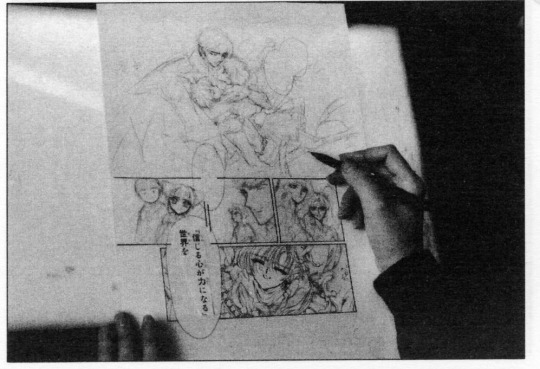
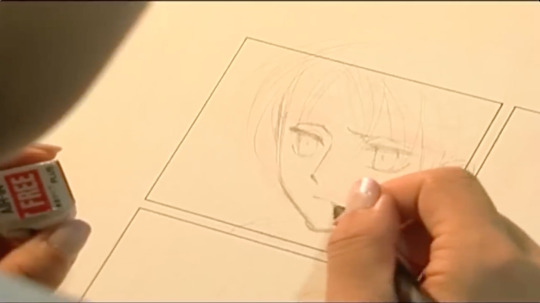
3.) The inking stages for the steps of Magic Knight Rayearth are inked mainly using a Pigma 0.05 or Kaimuji marker or brush. When Mokona was drawing Rayearth Mokona had strong drawing pressure so her lines became thicker She changed pens as soon as she noticed it her strong drawing pressure caused Mokonas tip of her pen to break quickly they often used 4 to 5 bottles a day for inking.
4.) Next up the beta stage, after they are done with inking they erase and check it again After that the members add solids the tool used is a brush pen to fill in areas like hair and stuff. They use ink that is resistant to water because if it is water resistant the area will become thin when the eraser is applied.
The steps for rough and sketch are used in their other works only the materials that are used for inking change consistently Depending on the series
5.) Next is the toning stage when they add screentone traditionally to a manga page, when it comes to screen tone they make sure that no more appears in the overlapped areas Clamp use a circular blade type cut when they apply screentone traditionally to a manga and small areas might be scrapped with a sand eraser scrapping the tone can change the texture of the object. They consider the effect and carefully cut it and their grain to the tone and know in which its neatly scrapped directions are not scrapped.
In Rayearth tint and gradation tones are used, and a little gala for the screen tone of the manga.
6.) This is the last stage of Clamp creation in drawing manga. The last stage is to express light and create glamorous images white is used for it. when applying white fluid to the image which is done by flicking the brush on the correction fluid with the rim of the container the effect changes depending on the concentration of the liquid. You can add white to the toothbrush or flick it with your finger. It changes the effect of the image. If you add fine white dilute it with water to adjust for the white. Clamp uses quirk drawing because the pen can be put on the white later.
This technique was applied in other manga like Tsubasa, Card Captor Sakura, and their other works. They used the same white ink to make a beautiful panel.
Next
#clamp#x/1999#meta#card captor sakura#card captor clear#tsubasa reservoir chronicle#chobits#tsubaki nekoi#Nanase Ohkawa#Satsuki Igarashi#Mokona#magic knight rayearth#xxxholic#kobato#angelic layer#tokyo babylon#my meta
634 notes
·
View notes
Photo

#koi#恋#love#CLAMP#ohkawa nanase#okazaki takeshi#josei#romance#drama#slice of life#manga#manga cap#mangacap
9 notes
·
View notes
Text
Visiting the CLAMP Exhibition in Tokyo to celebrate 35 years of the legendary manga collective

From July 3rd to September 23rd of 2024, The National Art Center in Tokyo held the CLAMP Exhibition, a major exhibition dedicated to the famous manga artist collective, showcasing around 800 original manuscripts in one of the largest exhibition spaces in Japan. In 2024 CLAMP are celebrating their 35th anniversary as professional manga artists and this exhibition is a culmination of that milestone.
CLAMP is a creative group of four women who have produced a range of iconic manga across a variety of demographics, from shoujo to seinen. Some of their most notable works include Tokyo Babylon, X, Magic Knight Rayearth, Cardcaptor Sakura, Chobits, Tsubasa – RESERVoir CHRoNiCLE – and xxxHolic. They started as a larger group of 12 women in the late 1980s producing doujinshis of popular works such as Saint Seiya and Captain Tsubasa. They made their professional debut in 1989 on the pages of the third edition of South magazine (Shinsokan) with their original story RG Veda. By that time, the collective had shrunk to six members, eventually leading to its ultimate formation with its four current members: Igarashi Satsuki, Ohkawa Nanase, Nekoi, and Mokona.
The idea to hold a dedicated CLAMP exhibition first came about in September 2019 from one of CLAMP’s main publishers, Kodansha, after the successful run of the Cardcaptor Sakura Exhibition – the Enchanted Museum exhibition at the Mori Arts Center Gallery, which would later travel to other cities in Japan and Asia. Soon after, other publishers and companies related to CLAMP and their works formed a committee and started planning the exhibition. It took five years of planning but, according to one of the exhibition producers from Kodansha, from the very beginning there was a desire to do the exhibition at The National Art Center, a grand museum with spacious, eight-meters high ceiling exhibition rooms that have hosted exhibitions of legendary artists such as Salvador Dali, Caravaggio, and Monet. As far as I’ve been able to discover, this is the first time the Center has put on an exhibition of this scale focusing on women artists.
Read it at Anime Feminist!
143 notes
·
View notes
Text


[ 𝗬𝘂𝗲 ]
𝐚𝐧𝐢𝐦𝐞 Cardcaptor Sakura: The Sealed Card • 劇場版 カードキャプターさくら 封印されたカード (2000) 𝐰𝐫𝐢𝐭𝐭𝐞𝐧 𝐛𝐲 Nanase Ohkawa 𝐜𝐫𝐞𝐚𝐭𝐞𝐝 𝐛𝐲 CLAMP 𝐬𝐭𝐮𝐝𝐢𝐨 Madhouse 𝐝𝐢𝐫. Morio Asaka
𝘴𝘰𝘶𝘳𝘤𝘦: 𝘮𝘺 𝘴𝘤𝘳𝘦𝘦𝘯𝘴𝘩𝘰𝘵𝘴
#ccs#cardcaptor sakura#sakura card captor#clamp#the sealed card#mahou shoujo#mahō shōjo#90s nostalgia#90s kid#retro anime#anime scenes#90s anime#90s cartoons#anime#magical girl#yue#bgcardcaptorsakura
23 notes
·
View notes
Text
Fai: I want to go home. Syaoran: Are you all right? Do you feel unwell? Mokona: Mokona! Mokona’s here. Syaoran: I'll bring water. Mokona: Right! Fai: ...I'm going home. Kurogane: So you might not get this, but look, any time you say you want to go home in front of us, know that your home is right here.
A short Tsubasa World Chronicle dialogue posted on Nanase Ohkawa's Twitter. (Source) (Secondary Source)
#Tsubasa Chronicle#Tsubasa Reservoir Chronicle#Tsubasa World Chronicle#KuroFai#CLAMP#Kurogane#Fai#Tsubasa#Mokona#Fai and Tsubasa#Fai and Mokona#Kurogane and Tsubasa#Kurogane and Mokona#Mokona and Tsubasa#Social Media Skits
185 notes
·
View notes
Text
nanase ohkawa saying “so seishiro is seishiro because of his shoulders?” is like asking if a butterfly's one because of its wings
15 notes
·
View notes
Text
Reflections on The CLAMP Universe and Cardcaptor Sakura
The goal of this piece is to critique CLAMP’s narrative techniques and character design, with extensive criticisms of Tsubasa and xxxHOLiC, but with no intent to demean the characters themselves.
This is an informal essay that initially aimed to explore why Tsubasa Reservoir Chronicle "damaged" Cardcaptor Sakura and address the complicated emotions of Yue fans, along with the overlooked role of Yue as the Judge. My initial motivation was to critique Ohkawa’s treatment of Yue, but as I delved deeper, the complexity of the discussion grew, making it difficult to settle on a suitable title.
[Reader Notice]
This article is approximately 4,500 words, with logical connections between sections. Please avoid skimming if you intend to engage fully with my arguments.
The purpose here is to discuss the literary techniques and character development within these works. Although there is extensive criticism of Tsubasa Reservoir Chronicle and xxxHOLiC, this does not imply a disparagement of any character. If you hold a different perspective, I welcome well-reasoned discussion. I will not respond to overtly aggressive comments; please avoid bringing in fandom drama.
The original text was in Chinese and published in 2022. I used ChatGPT for the translation and did an initial proofread myself.
I have a lot to say about Clow’s characterization and CLAMP’s failure in portraying him, but I haven’t included it here. English-speaking readers who are interested in discussing it are welcome to message me privately.
[Contents]
I. General Overview of CLAMP II. On Scriptwriting Flaws in CLAMP, with Tsubasa Reservoir Chronicle and xxxHOLiC as Examples III. Cardcaptor Sakura: A Beautiful Yet Unrealistic World
IV. The Forced “Crossover” of CCS, Tsubasa Reservoir Chronicle, and xxxHOLiC V. The Tragedy of Yue and the Inevitable Character Deterioration in Clear Card
VI. Reflections on Clow/Yue Fan Interpretations
[Note] Unless otherwise specified, "CCS" refers to Cardcaptor Sakura as a series, excluding the Clear Card arc. Tsubasa Reservoir Chronicle (TRC)refers primarily to the manga version.
I. General Overview of CLAMP
Despite its popularity, CLAMP is particularly notable for its commercial acumen rather than other artistic strengths. Their success is evident in their keen market insight and adaptability across varied genres, especially in crafting small details (like character and artistic designs). However, they appear weaker when it comes to larger conceptual settings (such as worldbuilding). Although CLAMP’s illustrations are relatively impressive—particularly with art books being frequently published—their overall impact within manga itself is not as prominent. This is especially apparent in action scenes (like fight sequences), which often lack the necessary sense of motion and impact.
In terms of scriptwriting, CLAMP’s style could be described as “aesthetic-driven,” yet the content often veers into melodrama, with plots that lack logic and coherence. The themes they present can sometimes feel troubling: their works tend to emphasize "fatalism," placing excessive focus on an idealized notion of "love" that can feel unrealistic. Although CLAMP’s works are widely recognized, their scriptwriting level does not always match the acclaim they receive.
The following sections will delve further into the issues in their scriptwriting.
II. On Scriptwriting Flaws in CLAMP, with Tsubasa Reservoir Chronicle and xxxHOLiC as Examples The scripts for CLAMP’s works are primarily written by Ohkawa Nanase, hereafter referred to as "Ohkawa."
Many fans regard TRC as a masterpiece, claiming it must be read in tandem with xxxHOLiC to truly appreciate its depth. I strongly disagree with this viewpoint. Below, I’ll refute several key aspects that TRC fans often praise:
The time loop involving the Real and Clone versions of Syaoran and Sakura at the end of TRC.
The intricate timeline with Real Syaoran, Clone Syaoran, Real Sakura, and Clone Sakura is frequently lauded as "mind-bending" and as something that "feels ingenious once fully grasped." In reality, though, this couldn’t be further from the truth! The author clearly lacks the expertise to handle time loop narratives effectively, leading to a storyline that is confusing and difficult to follow. In TRC, Ohkawa uncomfortably relies on ideas of "fate" and "inevitability" to explain the time loop, such as when Real Syaoran steps into Yuuko's shop, setting off a chain of events. However, even if readers accept these ideas, once they unravel the plot, they encounter paradoxes typical in time-travel fiction—especially issues related to the grandfather paradox, which the author leaves inadequately resolved. Moreover, the concept of a time loop itself doesn’t require multiple versions of Syaoran and Sakura to complicate the storyline—this intriguing concept could be fully explored with just a single character.
In the ACGN (Anime, Comics, Games, Novels) world, time loop storylines generally lack the craftsmanship seen in genuine science fiction, and there’s a stark difference between them. (Even Steins;Gate, often considered a “masterpiece,” handles this somewhat clumsily.) Instead, I would recommend Isaac Asimov's The End of Eternity, which showcases meticulous planning, genius in handling paradoxes, and an exploration of philosophical and sociological themes.
(Side note: TRC has numerous bugs, and here’s an interesting one related to CCS: Before Clow Reed warped time and made his error, the King of Clow Country was Fujitaka. However, after Clow’s mistake, Fujitaka splits into Fujitaka and Eriol in the Cardcaptor Sakura world. So, where did Fujitaka, King of Clow Country, come from in earlier parallel worlds? Thus, TRC was awkwardly linked with CCS solely for commercial gain, which I’ll explore in depth in Section Four.)
The CLAMP-style "Sense of Fate" and "Angst" In other works focused on themes of fate, some authors manage to express it with the resonance of Greek mythology or Shakespearean tragedy, while others rely on plot conveniences. I must reiterate that fate is a challenging theme in the ACGN realm, and CLAMP’s works—particularly TRC and xxxHOLiC, where fate is often central—are notably flawed in this regard. By comparison, I feel Puella Magi Madoka Magica addresses this theme relatively well.
TRC constantly emphasizes "costs." In Fullmetal Alchemist, another ACGN work, the concept of “equivalent exchange” reflects the author’s world-building efforts, with fair exchange rules—for instance, achieving immortality requires the sacrifice of countless lives. However, TRC’s world-building is practically nonexistent, with no explanation of the exchange methods or rules. How does Yuuko's shop operate? What can be used as payment? What kind of payment achieves what kind of wish? Ultimately, everything is decided by Yuuko herself. And yet, this “cost” is central to much of the story's angst, such as Clone Syaoran’s connection to Sakura and Real Syaoran’s memories with Watanuki.
In xxxHOLiC, although Yuuko does not return, TRC introduces clones, time rewinds, and space-time distortions while still insisting “the dead cannot return.” This approach feels highly contrived. xxxHOLiC asserts that “there is no coincidence, only inevitability. Every cause has an effect.” This overly deterministic view, combined with weak plot logic, makes Watanuki’s “poignant waiting” in a butterfly dream sequence feel hollow, lacking emotional depth.
Stories that effectively handle fate as a tragic theme often move the plot and create a tragic hero through a series of reasonable yet inevitable events, even if they involve supernatural elements like mythology or religious undertones. A modern example would be Tolkien’s The Children of Húrin, where, under a curse, the protagonist unwittingly kills his closest friend, unknowingly commits incest, and brings misfortune to anyone who draws near, unable to escape the curse. Each event is plausible, whether attributed to the curse or his own character traits.
In contrast, CLAMP’s unexplained ideas of "inevitability, cause and effect, fate, cost," etc., feel more like lazy ways to resolve conflicts and advance the plot, exposing the creators’ limitations. CLAMP-style “angst” largely boils down to “because the author says so,” requiring readers to suspend logical thought entirely, fully accepting the premise, and simply reveling in the “beauty of fate” and the “angst” it supposedly brings. This approach seems best suited to an audience in their angst-filled teenage years, and can be termed “manufactured angst.” For readers who prioritize narrative consistency and well-built worlds, such a plot structure is not only unconvincing but also confusing and awkward.
The Interconnections and Plot Twists between and within TRC and xxxHOLiC When it comes to the interconnected references and callbacks in CLAMP’s works, I can’t provide an in-depth analysis as I haven’t thoroughly read all of them. However, when a story’s core and the author’s skill fall short, no amount of layered references, plot callbacks, or parallels in visuals and character design can add real depth; it all ends up feeling shallow, lacking in substance. To draw an imperfect comparison, the first five chapters of Dream of the Red Chamber, especially the prophetic verses, were crafted by Cao Xueqin. If Gao E had continued the work from there, would the overall effect still be as mesmerizing?
The fatal flaw of Ohkawa’s signature twists lies in the fact that the early foreshadowing and groundwork are nowhere near enough to support the later “stunning plot twists,” which often feel forced and contrived. Creating these twists isn’t difficult because the text can be intentionally ambiguous and open to various interpretations. For example, inserting a few seemingly irrelevant, vague lines into the dialogue leaves space to “explain” (or even improvise) later. They might even deliberately create ambiguous lines and scenes, allowing for a range of explanations further down the line.
Take, for instance, when Fei-Wang tells Real Syaoran, “You’re just like me” (in an exaggeratedly dramatic scene). Most readers might think this suggests they share a common goal, like resurrecting the dead. Yet Ohkawa’s later explanation could be that Real Syaoran is like Watanuki, who is like Clow, who is then like Fei-Wang, making Real Syaoran like Fei-Wang. However, this explanation lacks any logical foundation. The context, preceding events, and the story’s world-building all fall short of supporting such a forced interpretation. Yet this is then presented as “reasonable” in the story’s development, which doesn’t count as proper foreshadowing. Even so, these kinds of setups still earn admiration from many readers, which is honestly quite amusing.
(Side note: In Cardcaptor Sakura, Sakura once told Yue, “You and Yukito-san are so similar,” a line that Yue himself didn’t agree with. However, should Ohkawa decide to “expand” on this line in the Clear Card arc, it might trigger a similar shock effect.)
In summary, the values and narrative techniques in CLAMP’s works often seem rather peculiar, fully revealing Ohkawa’s limitations as a creator (even though she once audited literature courses at a prestigious university, her work’s results speak for themselves). CLAMP’s audience adores TRC and xxxHOLiC, while readers who don’t appreciate this style often struggle to continue and may even doubt the work’s quality. Unfortunately — or perhaps fortunately — I find myself in the latter category.
III. Cardcaptor Sakura: A Beautiful Yet Unrealistic World
Without the nostalgia of childhood, CCS is essentially a typical, idealized Mary Sue-style shoujo manga. It heavily emphasizes gentleness and a “magical allure,” which can come across as somewhat hollow. Even the progressive themes it’s praised for today, like “love transcending social status, identity, and gender,” aren’t unique to this work alone. During the golden age of Japanese manga, CCS wasn’t an especially standout work.
Like CLAMP’s other works, the CCS manga lacks real-world logic. However, as an idealized shojo manga, its conflicts are far less intense than those in other CLAMP works, so the absence of realism doesn’t feel as jarring. CCS presents a beautiful, dreamlike world (though this idealization is taken to an extreme in the character of Yue, the Judge; under close scrutiny, it’s doubtful this perfect world could hold up — more on this in Section Six). For this reason, CCS doesn’t quite qualify as an exceptional fairy tale. A true fairy tale should resonate with all ages, and telling a simple, pure, beautiful story well is no small feat. In the ACGN (Anime, Comics, Games, Novels) sphere, I consider Ghibli’s Castle in the Sky to represent the pinnacle of this genre. The Ghibli world might feel plausible, but CCS’s world feels purely fantastical. Healing, gentle stories also have layers, and when the setting and plot logic feel more realistic, the gentleness and healing resonate more deeply. Even so, CCS remains CLAMP’s best work in this genre and may even be their only truly “pure” story. Due to CCS’s theme, the work almost entirely avoids the script flaws discussed in Section Two, with none of the dark, glamorous style, twisted, chaotic plotlines, or subtly angsty themes that characterize many other CLAMP works.
About 80% of CCS’s immense success can be credited to its anime adaptation. (Though I haven’t researched the manga’s sales or the anime’s viewership ratings, this is my subjective conclusion.) Compared to the manga, the anime’s storyline is more well-rounded (such as the addition of Syaoran competing for the cards and Li Meiling’s character). The characters are portrayed in more depth, addressing many of the manga’s script issues and removing some elements difficult to accept in reality (such as Sasaki Rika’s teacher-student relationship). The anime feels more grounded than the manga, enhancing its healing effect without feeling hollow. Furthermore, the anime’s art direction is more refined and diverse (with additional outfit changes and Clow Card designs). Combined with factors like the peak of Japanese animation’s expansion at the time, these aspects contributed to CCS’s widespread popularity.
In summary, CCS is CLAMP’s only purely sweet shojo manga, suitable for all ages and wholesome, and this is what most CCS fans love about it. This fanbase doesn’t entirely overlap with the audience for CLAMP’s other works.
IV. The Forced “Crossover” Between CCS, Tsubasa Reservoir Chronicle, and xxxHOLiC
In discussions surrounding Cardcaptor Sakura (CCS), it’s common to see people recommending Tsubasa: Reservoir Chronicle (TRC) and xxxHOLiC, claiming that these works "explain" certain plot points in CCS. I strongly disagree with this viewpoint. I believe that if you enjoy the healing, wholesome themes of CCS, along with elements like magical girls and costumes, it’s best to avoid watching TRC and xxxHOLiC, and there’s no need to delve into CLAMP’s other works either.
The crossover between CCS and TRC/xxxHOLiC fundamentally disrupts CCS’s independent charm for two main reasons:
Firstly, CCS is entirely different in genre from other representative CLAMP works, especially TRC, as discussed in Section Three.
Secondly, using character names from CCS in TRC and xxxHOLiC is purely a commercial tactic, designed to draw attention by tapping into CCS’s popularity. Beyond shared names and appearances, there’s essentially no thematic or plot-based connection between TRC/xxxHOLiC and CCS.
Since TRC appears to have a closer link to CCS, I’ll primarily use it as an example for analysis.
So, what is TRC really about?
[Plot Overview]
In summary: The first half consists of episodic dimension-hopping stories, with Syaoran traveling through various parallel worlds to collect feathers to save Sakura. Most characters in these episodic arcs are from past CLAMP works. The latter half focuses on unveiling the truth (with a slew of Ohkawa-style twists) and the final confrontation with the antagonist, though this section’s handling of time loops is poorly executed, as previously discussed.
In detail: At the moment of Yuuko’s death, Clow Reed briefly wishes she could "open her eyes again." Because of Clow’s overwhelming magical power, this wish stops Yuuko’s time and distorts space-time. This thought ultimately takes form as Fei-Wang Reed, the final antagonist. Fei-Wang orchestrates a series of events to torment Syaoran and Sakura (hence the episodic dimension-hopping). Meanwhile, Yuuko and Clow work to restore the timeline and correct this mistake. In the end, their efforts succeed, but both die in the process, leaving Syaoran and Sakura with a slightly better outcome.
[Characterization]
Syaoran: The classic shounen protagonist — brave, kind, and determined to protect the heroine.
Sakura: A gentle, kind heroine who initially needs saving but gradually grows into a resilient and courageous character.
Clow Reed: A kind, gentle figure driven by remorse, striving to make amends for past mistakes.
As we can see, this has virtually no connection to CCS: the plot is unrelated, and changing the characters’ names wouldn’t impact the story in any meaningful way.
The Syaoran and Sakura in TRC are merely the typical shounen manga leads, sharing almost nothing with their CCS counterparts, particularly Sakura.
In TRC, Clow serves mainly as a plot device to supply the core conflict and backstory. Over half the manga passes with Clow appearing in fewer than 20 panels (I counted carefully; his longest scene is a four-page flashback from Sakura’s memories). His characterization is minimal and fundamentally inconsistent with CCS’s depiction of him as whimsical, eccentric, and morally ambiguous. Aside from their names and appearances, the only connection between Clow in TRC and CCS is the title of "great magician." In TRC, it’s explained that Clow left the CCS world due to a space-time distortion and that he had to “fill in the gaps” in a parallel world to correct his mistake. This connection is entirely forced—why would he need to “fill in the gaps” to fix his mistake? There’s no reasonable explanation. If the story were altered so that Clow from Cardcaptor Sakura simply passed away naturally, while TRC featured a powerful magician named “deeR wolC” who distorts time and space and works to make amends... it wouldn’t change the story in any meaningful way.
In fact, after CCS concluded, Ohkawa gave several well-known interviews where she firmly stated (paraphrased): “CCS is not in the same universe as other works. CCS is complete with no sequel.” This clearly indicates that Clow’s death in CCS has nothing to do with TRC. The claim in TRC that "Clow left his original world to atone for his mistake" is just a convenient excuse by Ohkawa, who lacked the scriptwriting interest to fully address TRC’s central conflicts, so she used Clow as a scapegoat. Using Clow across TRC and xxxHOLiC ultimately came at a high cost — it led to a complete breakdown of his character. (This, of course, is also one reason I find Clow and Yuuko as a pairing highly unconvincing, an issue I’ll discuss in more detail later.)
In conclusion, CCS is a self-contained, internally consistent work that doesn’t need and shouldn’t be linked to TRC or xxxHOLiC. However, the Clear Card sequel to CCS shows signs of merging with these two works. While CCS is itself a commercial work, this pursuit of greater profits by capitalizing on CCS’s popularity to promote more commercialized works undermines CCS’s simplicity, purity, and beauty — a counterproductive move.
Syri once said that TRC is “a product of CLAMP’s creative burnout, now stale and contrived.” I find this assessment very accurate. Although early CLAMP works like RG Veda and X have melodramatic plots, they are filled with creativity, inspiration, and even a touch of BL aesthetics. However, TRC is simply a repackaging of these early works, commercially reprocessed. Comparing the iconic moments in early CLAMP works with those in TRC and later works, the former have a powerful emotional impact, while the latter feel more like beautiful but soulless dolls. This phenomenon only becomes more evident in CLAMP’s later works, especially in Clear Card.
Some critics say, "CLAMP’s commercial strategy resembles Apple’s: build a closed ecosystem (story chain), reuse core templates (worldview), and extract the last drops of value from classic characters (popular characters)." This commercial model is fully realized in TRC, and perhaps TRC’s success gave CLAMP a taste for this approach, leading their subsequent works to lean even more toward commercialization. (Though, personally, I think a comparison to Marvel Cinematic Universe might be more fitting.)
The artistic merits of this “repackaged content” have already been discussed in detail in Section Three.
V. The Tragedy of Yue and the Inevitable Character Deterioration in Clear Card
(Due to heightened emotions during writing, this section may be somewhat disorganized and will be refined later.)
Yue embodies many classic CLAMP elements, incorporating various iconic traits from earlier CLAMP works.
Design Elements: Cherry blossoms (anime-only, during "The Final Judgment"), Tokyo Tower (also anime-only, appearing in "The Final Judgment"), the moon (Yue is literally a symbol of the moon), and feathers — all of these are signature CLAMP motifs.
Art Style: In the manga, Yue’s eyes, hair, and feathers are rendered with an intricate, lavish style, closely resembling classic CLAMP aesthetics. Although CCS generally adopts a simplified, clean shoujo style, Yue’s design still stands out as distinctly different from other characters.
Character Traits: Yue relies on his master and develops feelings due to his subordinate position. When his master reincarnates, he is destined to fall into a one-sided devotion, with slumber and waiting themes that define his existence…
The problem is obvious: Yue’s aesthetic and character setup don’t quite align with CCS’s themes. He feels more like a character suited for one of CLAMP’s earlier works, better placed in an intense, "fate-driven tragic romance" typical of the CLAMP style.
Furthermore, if Yue’s character were developed with realistic logic, it would likely mean his attachment to his former master, Clow, is deeper, making it harder for him to connect with his new master. This setup contradicts the idealized shoujo philosophy where the protagonist is universally adored. In other words, in a shoujo manga, everyone should love the universally beloved heroine, Sakura Kinomoto, and Yue’s design clearly contradicts this convention.
When CCS was created, the character settings might have been somewhat spontaneous, carrying over traits from CLAMP’s earlier style. This led to characters like those with dual personalities or souls (like Yukito and Yue), as well as conflicting lines and official character details. There’s also added complexity, such as one persona still having feelings for a former master. However, as CCS gained popularity, these casual elements turned into significant issues. As a gentle, comforting shoujo manga, CCS relies on its core themes staying intact, but Yue’s character starkly exposes CCS’s lack of realistic logic and could potentially undermine its themes of warmth and kindness.
As a commercial team, CLAMP’s Ohkawa may lack the writer’s attachment and regard for her characters, as seen previously with her treatment of Subaru. Even if Ohkawa did want to develop her characters carefully, as mentioned earlier, her skills might not fully support this. So, what kind of treatment could Yue receive in this context?
Most likely, Yue would be deliberately sidelined or subjected to official out-of-character (OOC) moments, eventually resulting in his character’s decline.
And thus, in Clear Card, we see a Yue who doesn’t resemble "Yue" at all: outwardly cold, but actually a soft-hearted tsundere; he seems like he’s going to scold Syaoran, but instead gently touches his face (an utterly puzzling scene); he quickly devotes himself entirely to protecting Sakura, showing almost no reaction to Clow (although in the original series, every mention of Clow subtly affects him) and even goes so far as to scold Eriol over Sakura…
The original CCS ends without revealing whether Yue eventually moves past his heartbreak or remains sorrowful. However, at the very least, Eriol left open the possibility of accompanying Yue, preserving the integrity of CCS’s theme. However, Clear Card, as a direct sequel, fails to address Yue’s unresolved issues. No one comforts or regards him as an independent being — everyone simply prefers Yukito. Under these circumstances, the attempt to create a warm, healing atmosphere only weakens the other characters. The character who suffers the most from this decline is Eriol. As the only one who truly understands Yue’s feelings and experiences, he should offer comfort, even if he isn’t Clow. As Clow’s reincarnation, he absolutely should. In the original CCS, he pays particular attention to Yue, not only focusing on Yukito. In Clear Card, even if actual conversations aren’t shown, we might assume private exchanges took place between Eriol and Yue. However, in scenes where “Eriol, Kero, and Yue meet,” there’s no indication of any private communication between Eriol and Yue. Eriol even leaves a message for Kero but not for Yue. How is this “kind”? He shows more concern for Ruby than for Yue. Doesn’t he recognize Yue’s gentle, soft-hearted nature? Syri once criticized the overemphasis on “Syaoran x Sakura” and “You’re the best!” moments, and this view is valid. The deliberately heartwarming atmosphere feels hypocritical in these circumstances.
Conclusion
In the original CCS, Yue is the only truly tragic character, while the other character designs remain largely intact.
Viewing CCS, TRC, and xxxHOLiC together, Clow’s character has completely deteriorated (and if Watanuki in xxxHOLiC is made into Clow’s reincarnation, this would collapse entirely), with some associated characters also affected.
Considering CCS, TRC, xxxHOLiC, and Clear Card as a whole: all the characters have ultimately suffered from inconsistency and decline.
VI. Reflections on Clow/Yue Fan Interpretations
Firstly, for me, fan creation isn’t just entertainment—it’s a way to explore interesting questions and think about life. So, I tend to analyze works and characters with a more realistic perspective, blending in my personal experiences and thoughts. I’ll often dive into a whole “plate of dumplings” (the entire work) just for the “vinegar” (an aesthetic or intriguing concept, not just a character or pairing). Since I can’t make my own “dumplings,” I rely on others' works for this “vinegar” that can only be savored along with the “dumplings” (meaning character issues need the context of plot, setting, etc.). In Clow, Yue, or Clow and Yue, I’ve found that exact “dish of vinegar” I crave.
Secondly, my fan creations lean toward a “gap-filling” style. I enjoy constructing stories and backgrounds that align with the original based on limited information. I especially like exploring what might have happened before the main storyline—like stories of Clow, Keroberos, and Yue.
But honestly, CLAMP’s works make terrible material for fan creation:
As I mentioned, CLAMP’s worldbuilding is loose, the plot lacks logic, and it just doesn’t hold up to scrutiny. Using any reasonable logic to think about these settings just ends in "meltdown."
CLAMP’s works are “fan creation killers,” leaving little room for fans to build on. They churn out spin-offs, novels, audio dramas—ways to boost their commercial value and basically dictate how fans should interpret the work. But I don’t want to follow their way of doing things. CLAMP throws away the “vinegar” I crave, instead serving up industrial sugar or blades that I can’t stomach.
A Short Piece
This is a short piece I wrote two years later to counter some CLAMP fans.
If creating a character requires 100% effort, then CLAMP’s portrayal of Yue is 60% creation and -40% destruction, leaving a mere 20% of creativity. As for Clow, his character is so poorly constructed and hollow, riddled with logical contradictions, that I can’t even evaluate the effort needed to create him. Honestly, Clow is just a lazy storytelling device Daioh uses to set up background and conflict, saving herself a load of work—way more than she put into Clow and Yue as characters!
Let me be blunt: the core elements and relationship of Clow and Yue are simple (art aside): Clow is a half-British, half-Chinese great magician with knowledge across East and West who created the 52 Clow Cards (a spirit deck for divination) and the guardians Keroberos and Yue (representing the sun and the moon). He deeply loves his creations, treating them as his children. Before passing away, he used foresight to prepare for the next master and ensured that those connected to the Clow Cards would be drawn to the guardians. Clow is gentle, wise, and mischievous; Keroberos is lively, Yue is calm and pure, with the moon’s nature, and deeply loves Clow. It’s that simple. Since CCS ended, every CLAMP work depicting Clow and Yue has steadily destroyed these core aspects, completely ruining both characters and their relationship. So, where exactly is this "characterization" CLAMP supposedly offers?
And as for that argument, “you shouldn’t criticize creators while enjoying their work”—that tired “fan rule” against criticizing creators—it’s ridiculous. CLAMP makes manga for profit (I call it “money-grabbing” because CLAMP has no professional ethics), and it’s the readers who fund them! Discussing CCS online adds to its popularity; in my youth, I even bought merchandise. In other words, I paid for CCS as entertainment, only to find out it’s trash after looking closer—so shouldn’t I be allowed to criticize the creators? Frankly, those few core traits and some art are more than enough to fuel all my writing and headcanons, far surpassing CLAMP’s shallow portrayal of Clow and Yue. Does my passion for Clow and Yue have anything to do with CLAMP’s flimsy plotlines? Clow and Yue can easily be separated from the original work and its creators. I won’t accept any rhetoric about "you can’t criticize creators" or “you have to know how to make your own ice before judging a refrigerator!” I only care about the core elements here. I paid for this and can take what I like from it to fuel my own enjoyment.
And to end with my usual bluntness: Anyone who backs CLAMP can’t truly love Clow Reed and Yue. You just don’t honestly care about these two characters.
#clamp#clamp manga#cardcaptor sakura#xxxholic#tsubasa reservoir chronicle#clow reed#sakura kinomoto#syaoran li#sakura x syaoran#yue#yuuko ichihara#yue reed
9 notes
·
View notes
Text





As fun as this treasure is, I'm ready to let another CLAMP fan enjoy it and it's up for auction on Ebay. Auction ends 7/3/24 6:08pm PST - that's less than 2 days left! https://www.ebay.com/itm/156270325198
I wanted to share this neat item with you all! This is a shikishi style autograph board signed by Satsuki Igarashi, Nanase Ohkawa, Tsubaki Nekoi, and Mokona of CLAMP. CLAMP made their first US public debut at Anime Expo 2006 in Anaheim, Ca. And to my knowledge, it may have been the only time they made a public appearance in the US to date. Wiki’s report that “They were well received at the convention as fans completely filled all 6,000 seats present in the auditorium of the focus panel in addition to more on the waiting list.” I was there as a fan and recall the lengthy line and wait to get in. I was cosplaying as Sakura from the Season 2 opening of Card Captor Sakura that weekend and I was super excited to be there! During the panel the CLAMP Wonderland animation was shown. At the end of the panel a raffle to get into a signing room was held. Though I don’t recall the number of people who received signing tickets, they were very limited. Winners were escorted to a signing room, where they were given this event exclusive art board while waiting in line for the signing. Characters featured are Ichihara Yuuko from xxxHOLiC, Li Syaoran from Tsubasa: RESERVoir CHRoNiCLE and Chii from Chobits. :)
#CLAMP#CLAMPmanga#clampmangaka#clampanime#ccs#cardcaptor#cardcaptorsakura#syaoranli#tsubasareservoirchronicle#xxxholic#yuukoichihara#ichiharayuuko#chobits#chii#chobitschii#sakurakinamoto#clearcard#mahoushoujo#magicalgirl#persocom#magicalgirls#anime#manga#shikishi#retroanime#animeexpo#animeexpo2024#autograph#autographed#anime art
11 notes
·
View notes
Text
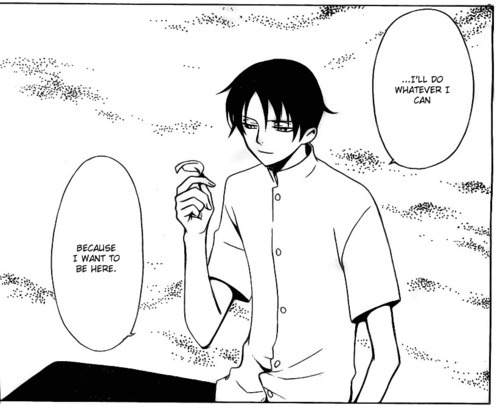

"God told me that if I had any wishes, that they would grant just one." - Kobato {Kobato}
"...I... I still... haven't granted it. ... Your wish... I promised... ...that I'd grant it... ...I promised..." - Kimihiro to Yuuko {Holic}
"I answered that I wanted to live." - Kobato {Kobato}
"I'll do whatever I can because I want to be here." - Kimihiro {Holic}
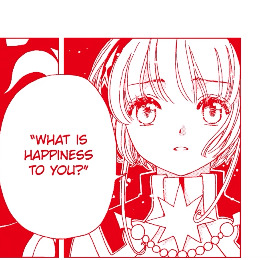
"What is happiness {/to you}?" - {Chobits}; Dark Chii {as Red 'Atashi'} to Chii {Pink 'Atashi'} {Card Captor Sakura: Clear Card Arc}; Lilie Shinomoto to Sakura {Sakura relating this to a canon Non-human Character}

"My wish is for you to go on existing. That's ALL I want." - Yuuko to Kimihiro {Holic}
"But the one Tsuyuri {Kohane} cares about most is YOU." - Doumeki to Kimihiro {Holic}
"{Doumeki} didn't want {YOU} to vanish forever." - Yuuko to Kimihiro; on Doumeki {Holic}
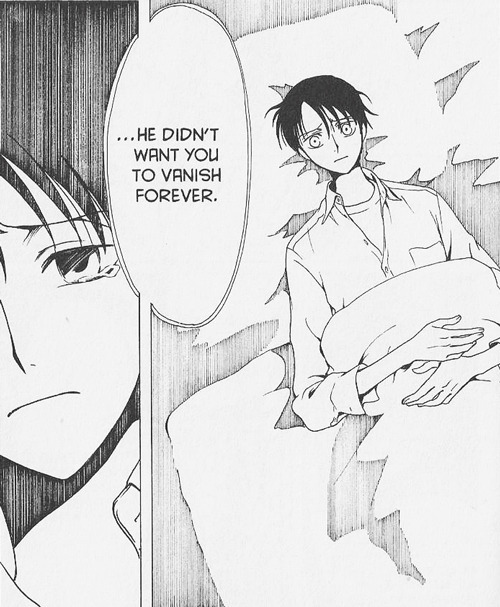
"To be happy... that's a rather vague goal, don't you think?" "{YES}, but that's what makes it {interesting}. All the more interesting... in that most people would consider it {IMPOSSIBLE}." "{Impossible}. How so?" "Well, you need a {life}... a {soul}. And if you're not alive... If you don't have a {soul}... what then? Then happiness is just a story... in a fairy tale book." - Zima to Dita; {Chobits}
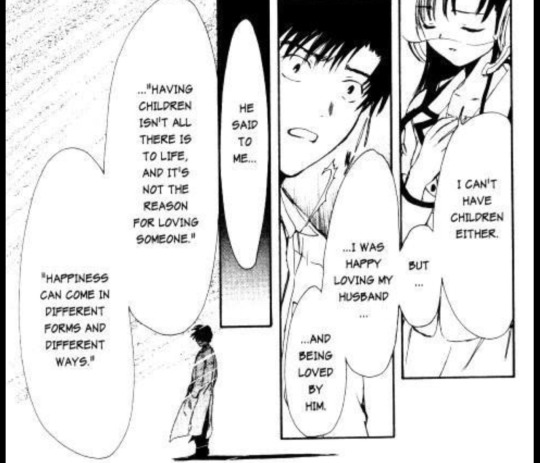
"Even if a {combination}/{of two [or more] people} Looks a bit 'odd' on the outside... They can still be happy on the inside." - Ichiro Mihara {Angelic Layer} x {Chobits}, to Chitose Hibiya (later Chitose Mihara {Kobato})
"The greatest happiness for me is to let the person I most like have the most happiness." - Tomoyo; {about Sakura} {Card Captor Sakura}
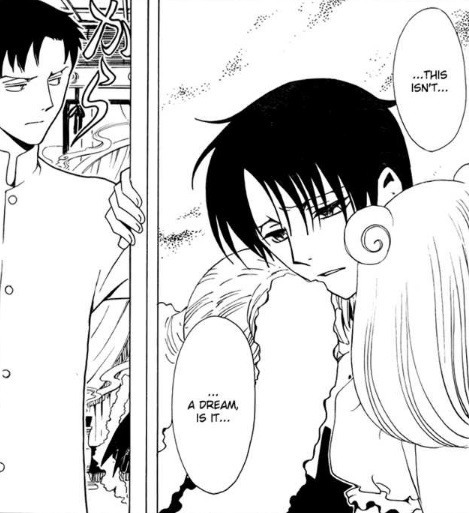
"One day a man had a dream. He dreamed that he was a butterfly. He fluttered and fluttered, flew and flew. He so loved the feeling of freedom… That he decided that he was a butterfly. But when he woke up, he wasn’t a butterfly. He was a human after all. Then the man thought… “I wonder if I, The Man, dreamed that I was a butterfly… Or if this moment is truly the dream. Maybe the man I am now is a dream that a butterfly is having"" - Haruka Doumeki, who primarily communicates to Watanuki through dreams; relating a story, about dreams {Holic}
"Some things are worth caring about." - Doumeki to Kimihiro {Holic} {Heavily implied to be about Watanuki}

"{Yuuko said} 'at this rate', {Watanuki would} 'disappear'" - Implied by Doumeki {Holic}
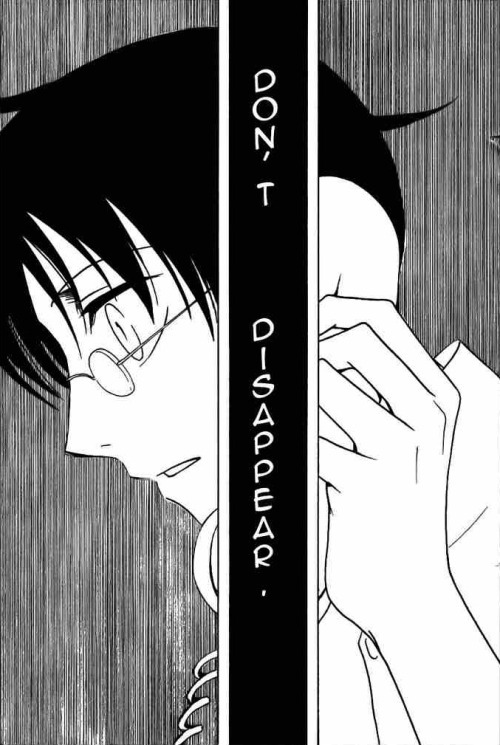
"I don't love Chii because 'I wanted' to 'make love' to {Chii}.
'I wanted' to 'make love' to {have sex with} Chii because I LOVE {CHII}." - Hideki Motosuwa, on Chii {Chobits}
"Chii Persocom." "Yeah" "Chii is not human." "Yeah"
"Can't do SOME things. ..." {Implied as: 'Have sex with'}
"YEAH." - Hideki; - Chii to Hideki {Chobits}
"Happiness... That is..." - Someone Just For Me {Chobits} (Storybook)
"Maybe the man I am now is a dream that a BUTTERFLY is having"
"Because if we can all find that special person{/people}, then the world would be a happy place. The love that we all feel may not be the SAME, but it won’t matter if it’s the ‘someone just for you’." - C.L.A.M.P {Chobits}
"Happiness doesn't just come in one shape." - Ichiro Mihara {Angelic Layer} x {Chobits}, implied relevant to Ichiro and Chitose Hibiya (later Chitose Mihara {Kobato})
"I wanted to create, with {C.C.S}, a series with a girl who saw {MINORITIES} as normal. For example, Syaoran and Eriol are foreign exchange students, but to Sakura they’re the same as {people} who transferred in from a local school. Similarly, Sakura believes in all the forms of love {Sakura} sees. Towards the end {of C.C.S's 1st series} I had several characters give advice to a worried Sakura, showing that there are many kinds and forms of love. I wondered how the series would be received, since it ran in Nakayoshi, but it was received better than I expected. - Nanase Ohkawa (C.L.A.M.P) {x}
"Ohkawa: (…) I am glad that the readers are happy that Sakura and Syaoran got together, but that anyone would think it’s {just} because they make a normal {combination}/couple… it’s a little disconcerting. Sakura didn’t chose Syaoran because {Syaoran}'s a boy close to {Sakura} in age. If Syaoran had been a girl, if they had been far apart in age, as long as {Syaoran} was still Syaoran, I think Sakura would have fallen in love with {Syaoran}. It’d sadden me if you thought they’re a good {combination} because they’re 'normal'." - Nanase Ohkawa (C.L.A.M.P) {x}
"Normal? What’s normal? To only do what the masses do? And what is the benefit of that? Where is the problem in adopting a custom that is ‘abnormal’ if it has no negative affect on the world at large?" - Yuuko {Holic}
"I don't see anything wrong with being what everyone calls 'not normal'." - Yuuko to Watanuki {Holic}
-Observations made when rereading many C.LA.M.P Lores (To Be Re-Compiled, Someday)

Doumeki, probably:
"I don't love Watanuki because I wanted to 'have sex with' Watanuki."
"I wanted to 'make love' to Watanuki because I love Watanuki"
{AND IF WATANUKI EVER ISN'T FULLY 'HUMAN' ANYMORE?}
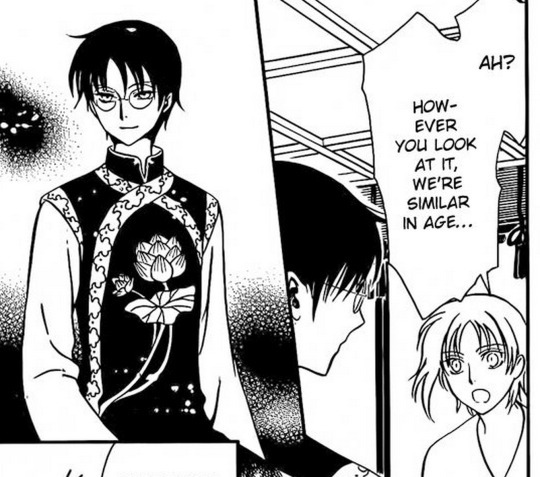
{Holic x Drug & Drop Cross-over} (Read panels right-to-left)
#clampverse#holic refs#douwata analysis#douxwata#shizuka x kimihiro#kimihiro refs#ccs refs#a spec kimihiro#ace kimihiro#a spec doumeki#queer doumeki#ace and queer doumeki#ace and queer kimihiro#(bANGS FISTS DOWN)#(ILL RECOMPILE ALL THIS WHEN I CAN PROPERLY REFIND ALL THE SCENES IN H.Q. TO G I F MYSELF B U T)#(HI YES HELLO THE EXACT KIMIHIRO x KOBATO PARALLEL I FOUND WHILE DIGGING THROUGH ENDLESS 'SOMEONE JUST FOR ME' LORES)#in which kimihiro actually does want to LIVE and doumeki is realizing it DOESNT MATTER if kimihiro lives as 'HUMAN' or NOT#(TheSame MightGo ForCertain C.C.SCharas c OGHS Im Coming Back To Them Later Tho)#(ok I am using tags very limitedly for my blog though if you accidentally find this through Search I APOLOGIZE that its not rbable yet)#(Maybe I'll have a set finished in time for C.L.A.M.P Day Sobs)#(Im also trying to use less commonly used tags yEAH Anyway)#(SAVES ALL THESE FOR REFERRING TO AND FUTURE SCREAMING ABOUT HOLIC + C.L.A.M.P LORE)#rei spoilers
15 notes
·
View notes
Text

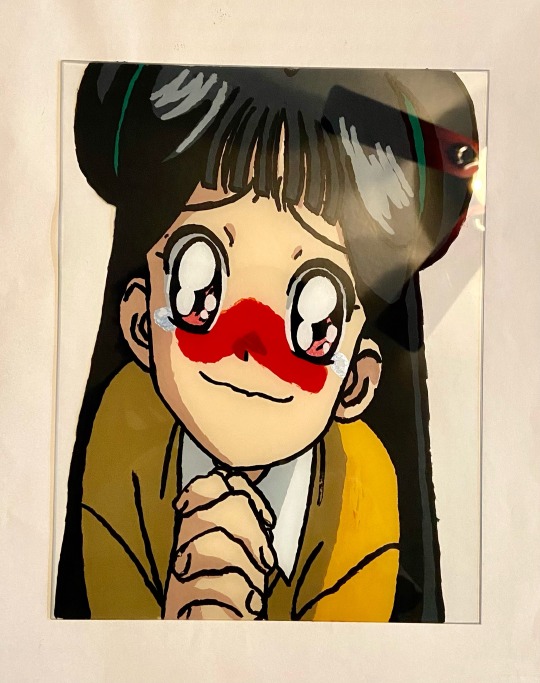



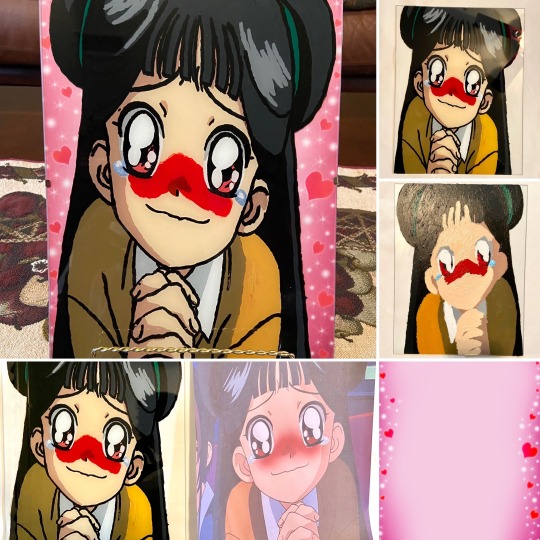
Sugar Crystal Empire: The brand NEW “Meilin Li’s Sweet Lovey-Dovey Gesture” 2023 8.5x11” in Glass Painting from “Cardcaptor Sakura” (March 2023 Birthday Edition)
Good afternoon, fellow Cardcaptors!!!! Special Happy Birthday to Meilin Li from “Cardcaptor Sakura” this 2023 today as the NEW “Meilin Li’s Sweet Lovey-Dovey Gesture” 2023 8.5x11” in Glass Painting is finally here at last for you to see!!!!
This glass painting features Meilin as she gives her cute lovey-dovey face expression to express her love for Syaoran all painting with pearlescent paints for her eyes with her own romance-theme background!!!! I’m really happy to make this for her as she’s one of my favorites!!!! I also love that I made her colors on a lighten tone outside of her original image especially adding pearlescent paintings for her eyes to sparkle (Definitely adding that effect for the Magical Girls in their romantic moments later on- it’s awesome!)!!! Meilin, forever & always you’ll be legendary to us- HAPPY BIRTHDAY!!!!
Hope you guys love her, please follow me on @lunargoddess40 for more Cardcaptor Sakura and other anime FanArt!!!!
Cardcaptors Forever & Always United- Release!!!!
P.S. This is a FanArt Glass Painting made by me!!!!
“Cardcaptor Sakura” & characters rightly belong to Nanase Ohkawa with CLAMP!!!!
#cardcaptor sakura#cardcaptor clear card#cardcaptor fanart#happy birthday#meilin lee#meiling li#clamp manga#anime art#anime#manga#cartoons#magical girls#masterpiece#art#art commissions open#paintings#glass painting#picoftheday
7 notes
·
View notes
Text
Clamp, un collectif de mangakas
Si vous êtes passionné de mangas, CLAMP est un nom que vous avez forcément déjà croisé. Ce collectif de quatre mangakas japonaises – Nanase Ohkawa, Mokona, Tsubaki Nekoi, et Satsuki Igarashi – est derrière certaines des œuvres les plus emblématiques du genre shōjo et bien au-delà. Depuis les années 1980, elles ont façonné des univers captivants, allant de la romance à la fantasy en passant par…
0 notes
Text
Clamp Art Style Analysis Masterpost

Part 1: Creation Process and Materials
Part 2: Series styles and Compare and Contrast
Part 3: Examining Concept art: X/1999, RG Veda, Tsubasa reservoir chronicle
Part 4: Examining Concept art: xxxholic, Code Geass, Kabuki Bu
Part 5: Examining Concept art: Blood C
Part 6: Analyzing the art style
#meta#clamp#tsubaki nekoi#satsuki igarashi#mokona#nanase ohkawa#kobato#x1999#x/1999#x#tsubasa reservoir chronicle#tokyo babylon#angelic layer#chobits#rg veda#card captor sakura#card captor clear#code geass#xxxholic#blood c#kabuki bu#magic knight rayearth#legal drug#drop and drug#wish clamp#kamui shirou#kobato hanato#sakura minamoto#sue#sue clover
191 notes
·
View notes
Photo
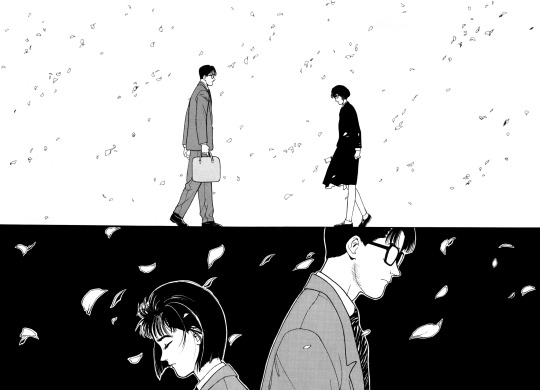
#koi#恋#love#CLAMP#ohkawa nanase#okazaki takeshi#josei#romance#drama#slice of life#manga#manga cap#mangacap
8 notes
·
View notes
Text
Three Favorite CLAMP Manga
About CLAMP Clamp, stylized as CLAMP, is an all-female Japanese manga artist group that was formed in the mid-1980s. Many of the group's manga series are often adapted into anime after release. The Artist Group currently consists of their leader Nanase Ohkawa, who provides much of the storyline and screenplay for all their works and adaptations of those works respectively, and three artists…

View On WordPress
1 note
·
View note
Text
The Revenger trilogy is Alastair Reynolds at his most Nanase Ohkawa and I both love it and hate it (okay, I just hate the last half of Bone Silence).
Someone remind me to write a big dramatic blog post about why revenger by alastair reynolds is amazing
3 notes
·
View notes
Link
[CLAMP INTERVIEW]
On this CLAMP Day, I present you with a talk between CLAMP's Nanase Ohkawa and Toshihiro Hirano, the Director for the Magic Knight Rayearth TV Anime.
This talk was first published in the "Magic Knight Rayearth Scenario Collection 1" (1995)
Enjoy it!
More CLAMP interviews to come!
18 notes
·
View notes